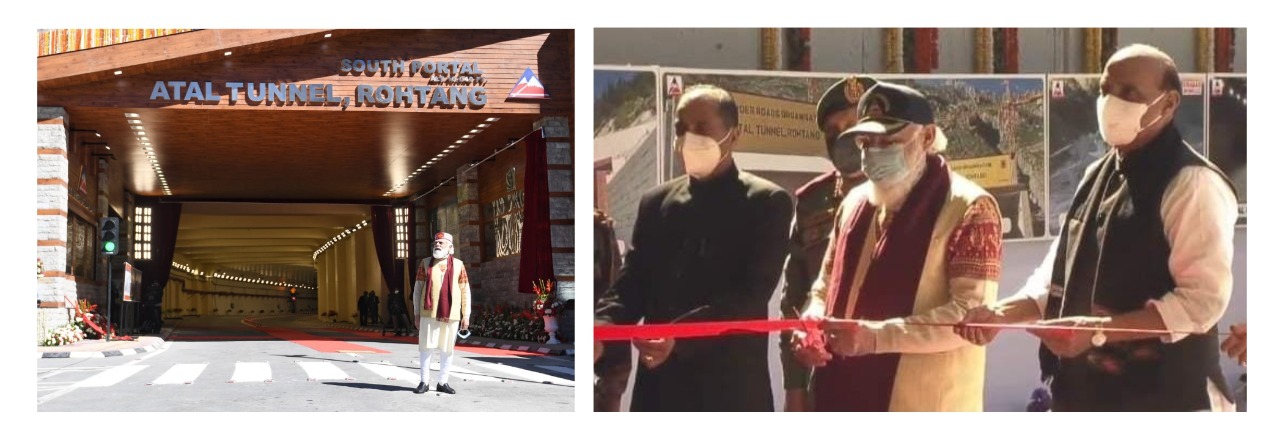October 3, 2020, was a great day for the people of Himachal and Ladakh. It was on this day that Prime Minister Narendra Modi inaugurated the world’s longest underground highway and dedicated it to the nation. Named Atal Tunnel, as a tribute to former Prime Minister Atal Bihari Vajpayee, it is a 9.02 km-long underground highway beneath the Rohtang Pass of the Pir Panjal range, Manali, Himachal Pradesh.
Stressing on the importance of the tunnel, particularly from the army and strategic point of view, the PM called the tunnel an “engineering marvel”. He said that his govt could complete the project in a record time, which is in itself is a big achievement.
Recalling former Prime Minister Atal Bihari Vajpayee’s keen interest in the tunnel, and his love for Himachalis and Ladakhis, Modi said the tunnel was of a great strategic importance towards easy access to the LOC and LAC areas, besides giving an ‘engine of progress’ for the people of Ladakh and Himachal. In a way, he said, it was the lifeline for the people in the northern border areas.
PM Modi observed that scholars from Indian universities and from abroad should be encouraged to visit the tunnel and undertake research in this engineering work of amazing feat. Accordingly, he asked the relevant ministries of the govt of India to facilitate research work on the tunnel.
The tunnel was conceived nearly years ago, but the work on the project started only on June 28, 2010.Taking about 10 years to complete it, the project cost escalated to Rs 35,000 cr. The Border Roads Organisation (BRO), with the help of several other organisations, was the main ‘player’ behind the tunnel work all through the last decade.
To give a background, Rohtang Pass is so called because the word ‘Rohtang’ is derived from the Ladakhi/Buddhist word ‘Rohthang’, meaning ‘plain full of dead bodies’. The top of the pass has a vast expanse of plain area. In olden times, it used to so happen that, every winter, so many people trying to cross the pass would not survive the cold and tortuous journey, and hence the name ‘Rohtang’. Rohtang remains closed in winter, for six months, because of heavy snow. And that leads to parts of Himachal (Lahaul-Spiti) and the entire Ladakh region cut off for over six months of winter and spring.
The tunnel is a dream-come-true project not only for the people of Ladakh and Himachal but also for the Bharatiya Janata Party because it is the party’s beloved leader Atal Bihari Vajpayee’s dream realised. For the people of Lahaul-Spiti, it comes as the greatest gift because it will give them round-the-year access to the rest of the world. So far, these valleys remained cut off for at least six months during and after the winter season. They are so happy that they feel that this road access to the rest of the world throughout the year will be a game-changer for them. Not only freedom of movement as and when wanted, they hope that they will have rapid development throughout the year. Since no road transportation was available during the winter seasons, any kind of development activity would come to a standstill during those months.
Lahaul-Spiti has a tremendous tourist potential because of its ‘Ladakh-like’ landscapes and its rich Hindu-Buddhist tradition and culture. It would indeed be a huge draw for foreign as well as domestic tourists. Of late, thousands of tourists have started flocking to the hills in winter to see snow and the peaceful nature all around. Both Lahaul-Spiti and Ladakh are exotic lands. Their breath-taking scenario on the Manali-Leh route gives a traveller ‘out-of-this-world’ sights and a feeling of awe and wonder. As soon as you cross the Manali valley, you are greeted by ‘so unfamiliar’ kind of landscapes that would remind you of the Wordsworthian valleys of charm and thrill.
Going a little further up towards Ladakh, the landscape changes dramatically, giving way to what they call ‘moonscape’. Here come landscapes that are the ‘true Shangrilas’ of the world. The mighty, barren mountains all around you make you feel ‘belittled’, and one gets a chance to realise that we, as individuals, are just nothing but like a drop in the ocean. The sky-kissing peaks seem to stare at you as if they have a message for you: Pep up your courage and will-power as you have to go a long, hard way ahead.
For Ladakh, a fair-weather friend!
The tunnel is a great achievement, for sure. For Ladakh the tunnel will facilitate quicker access to Ladakh during the summer season, as there are several other passes beyond Rohtang that get blocked in winter. The tunnel has come as a ray of hope, and the beginning of change that could ultimately lead to the tunnelling of the other passes as well. The happiest among the Ladakhis are the businessmen and the transporters. Now they can have easier access to the rest of the world, and lesser time to go across the Rohtang Pass. That means that they can now reduce their expenses on transportation in a substantial manner.
Until a few months ago, nobody in Ladakh and Himachal was hopeful that the tunnel project would be realised so soon. I remember myself once talking at a gathering that I would be glad if it comes to ‘fruition’ in my lifetime. I had said this not because I was a pessimist but to reflect the views of the ‘aam people’ who held similar views. Today, now that they have been given this world-class tunnel to ‘enjoy its fruits’, they would have a great sigh of relief. Their tortuous journey across the Rohtang Pass would be a thing of the past, and yet the Pass will surely remain as a big tourist attraction in the summer seasons. Now a ride in the tunnel, that takes only 9 minutes, could be an added attraction. Earlier, the Rohtang Pass would take at least 4 hours to cross and reach the other side.
It is true that even though the Rohtang nightmare is over both for Himachalis and Ladakhis, the people of Ladakh still have many more passes to cross before they can reach Leh. There are several passes, of higher heights, between Rohtang and Leh which too remain blocked during winter due to heavy snowfall. But for the people of Lahaul-Spiti, the tunnel gives them 100% relief from having to cross the Rohtang Pass.
Distinguishing features
The tunnel has several distinguishing features: Having two lanes in one tube of 10 metres width, one in each direction, it is the longest underground highway in the world, with 9.02 km length, state of the art electromechanical system including semi-transverse and ventilation system besides remote-controlled fire-fighting and monitoring mechanisms. And, it also has telephone systems at every 150 metre, emergency exits at every 500 metre, and automatic incident-detection mechanism every 250 metre. All kinds of vehicles can have an operating speed of 80 km/h. Apart from that, the tunnel has several other features that make it stand out among the top-and-different tunnels of the world. Surely, with that kind of features, the tunnel itself would be a great tourist draw.
The tunnel’s south entrance is at the north of Dhundi on the Beas river, and the southern end of the tunnel meets the existing Leh-Manali highway near Teling village, west of Gramphu, which is the first village after the Rohtang Pass on the existing highway.
As pointed out earlier, for Ladakhis, the tunnel does give relief in the sense that it reduces the distance of 475 km between Manali and Leh by 46 km, and the travel time would be reduced by at least 4-5 hours. That means most of the smaller and lighter vehicles can reach Leh in a day quite easily. So far taxis and light vehicles would take almost 16-17 hours to cover the hilly distance, and that is a neck-breaking nightmare for any traveller! Heavy vehicles and buses take three days via the existing route.
The Ladakhis’ dream of having an all-weather highway via Manali is still a dream. There are several high passes like Baralacha, 16,040 ft, Shinkula, 16,800 ft, Taglangla, 17,480 ft, much more in height than Rohtang’s 13,050 ft. All of these passes need to have tunnels ranging from 10-15 km in length. Therefore, the Ladakhis say, more in jest that the Atal Tunnel is not, for them, an ‘all-weather friend’ but a ‘fair-weather friend’!
Strategically very important
As Prime Minister Modi said, the tunnel, built in a horse-shoe shape, is of national importance from the point of India’s security, particularly at the LAC and the LOC. Since it enables one a quicker access to mainland India for army movement and supplies of arms, ration etc., it has come at the right moment. Therefore, it is a morale booster for our security forces in the rocky and desert border areas. As Defence Minister, Rajnath Singh, who was also present at the inaugural function, this is the first such tunnelling, and several others are afoot. Some of them may be ready in the next couple of years. Given that, Ladakh too will have round-the-year access to the mainland. He assured that plan and work on these projects are already afoot.
It is said that the Moravian Mission was the first to take up the issue of a tunnel through the Rohtang Pass, in 1960. Later, Prime Minister Nehru had a plan to have a ropeway across the Pass, about which he had several discussions with local tribes. However, the tunnel project was conceived only in 1983.The feasibility study was first done in 1990, and the foundation-stone for the tunnel was laid on May 6, 2002 during Prime Minister Atal Bihari Vajpayee’s tenure. The first blast took place in 2010 and the last blast in 2017. Mainly, the tunnel was constructed using drill method known as NATM (New Austria Tunnelling Method). It was built with ultra-modern specifications in the Pir Panjal range of the Himalayas at an altitude of 10,000 ft.
All said and done, the Atal Tunnel is a kind of ‘miracle project’, rarely found elsewhere on this planet. And, mind you, this is just the beginning of a long journey of achievements. Greater heights of tunnelling through the sub-Himalayas too will begin soon. In fact, one such project is already taken up beyond the Rohtang Pass. In three years, that too may be completed. As Rajnath Singh says, it is only a question of time for the rest of the passes to have tunnels, and Ladakh to have an all-weather access to the rest of the world. It may look like a dream right now, just as the Atal Tunnel too looked like a dream when it was first talked about decades ago.
All this certainly help the people of Ladakh UT to hope that they too will have, one day, an all-weather access route. That will be the time when most of the strategic northern region of Mother India will be fully integrated in all senses! Ladakh, known as the crown of India, will then be ‘taking wings’ to higher heights of progress.
(The author is a New Delhi-based editor-at-large, columnist and professional speaker. Views expressed are his own)
Image Source:
(The views expressed are the author's own and do not necessarily reflect the position of the organisation)


